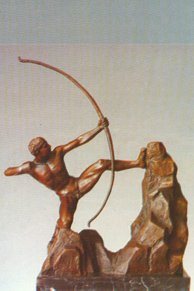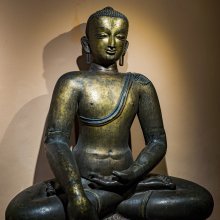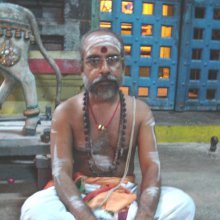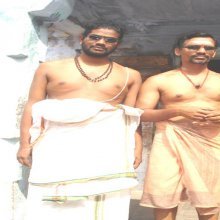Kavaca: 23 definitions
Introduction:
Kavaca means something in Hinduism, Sanskrit, Jainism, Prakrit, Buddhism, Pali, the history of ancient India, Marathi, Hindi. If you want to know the exact meaning, history, etymology or English translation of this term then check out the descriptions on this page. Add your comment or reference to a book if you want to contribute to this summary article.
Alternative spellings of this word include Kavacha.
Images (photo gallery)
In Hinduism
Dhanurveda (science of warfare)
Source: Wisdom Library: DhanurvedaKavaca (कवच) refers to a weapon (“amulet” or “armour”). It is a Sanskrit word defined in the Dhanurveda-saṃhitā, which contains a list of no less than 117 weapons. The Dhanurveda-saṃhitā is said to have been composed by the sage Vasiṣṭha, who in turn transmitted it trough a tradition of sages, which can eventually be traced to Śiva and Brahmā.

Dhanurveda (धनुर्वेद) refers to the “knowledge of warfare” and, as an upaveda, is associated with the Ṛgveda. It contains instructions on warfare, archery and ancient Indian martial arts, dating back to the 2nd-3rd millennium BCE.
Purana and Itihasa (epic history)
Source: archive.org: Puranic EncyclopediaKavaca (कवच).—A sage in the assembly of Indra. (Mahābhārata Sabhā Parva, Chapter 7). He was one of the sages of the western part. (Mahābhārata Śānti Parva, Chapter 208, Verse 30).

The Purana (पुराण, purāṇas) refers to Sanskrit literature preserving ancient India’s vast cultural history, including historical legends, religious ceremonies, various arts and sciences. The eighteen mahapuranas total over 400,000 shlokas (metrical couplets) and date to at least several centuries BCE.
Shaivism (Shaiva philosophy)
Source: Shodhganga: Iconographical representations of Śiva1) Kavaca (कवच) is the name of a deity who received the Prodgītāgama from Śūlin through the mahānsambandha relation, according to the pratisaṃhitā theory of Āgama origin and relationship (sambandha). The prodgīta-āgama, being part of the eighteen Rudrabhedāgamas, refers to one of the twenty-eight Siddhāntāgamas: a classification of the Śaiva division of Śaivāgamas. The Śaivāgamas represent the wisdom that has come down from lord Śiva, received by Pārvatī and accepted by Viṣṇu.
Kavaca obtained the Prodgītāgama from Śūlin who in turn obtained it from Sadāśiva through parasambandha. Kavaca in turn, transmitted it to through divya-sambandha to the Devas who, through divyādivya-sambandha, transmitted it to the Ṛṣis who finally, through adivya-sambandha, revealed the Prodgītāgama to human beings (Manuṣya). (also see Anantaśambhu’s commentary on the Siddhāntasārāvali of Trilocanaśivācārya)
2) Kavaca (कवच) or Kavacāgama refers to one of upāgamas (supplementary scriptures) of the Prodgītāgama which is one of the twenty-eight Siddhāntāgama: a classification of the Śaiva division of Śaivāgamas. The Śaivāgamas represent the wisdom that has come down from lord Śiva, received by Pārvatī and accepted by Viṣṇu. The purpose of revealing upāgamas (e.g., Kavaca Āgama) is to explain more elaborately than that of mūlāgamas (e.g., Prodgīta-āgama) and to include any new idea if not dealt in mūlāgamas.

Shaiva (शैव, śaiva) or Shaivism (śaivism) represents a tradition of Hinduism worshiping Shiva as the supreme being. Closely related to Shaktism, Shaiva literature includes a range of scriptures, including Tantras, while the root of this tradition may be traced back to the ancient Vedas.
Pancaratra (worship of Nārāyaṇa)
Source: archive.org: Isvara Samhita Vol 5Kavaca (कवच) or Kavacamudra is the name of a mudrā described in the Īśvarasaṃhitā 24.21-23.—Accordingly, “Two fingers beginning with the thumb and ending with the little finger, when formed separately into a casket with space in between, shall be in the small finger and other would respectively be the mudrās of śiras, śikhā, kavaca, (tanutrāt), protecting the body, astra and netra)”. Mūdra (e.g., Kavaca) is so called as it gives joy to the tattvas in the form of karman for those who offer spotless worship, drive out the defects which move about within and without and sealing up of what is done.

Pancaratra (पाञ्चरात्र, pāñcarātra) represents a tradition of Hinduism where Narayana is revered and worshipped. Closeley related to Vaishnavism, the Pancaratra literature includes various Agamas and tantras incorporating many Vaishnava philosophies.
Ayurveda (science of life)
Nighantu (Synonyms and Characteristics of Drugs and technical terms)
Source: WorldCat: Rāj nighaṇṭuKavaca (कवच) is another name for Parpaṭa, a medicinal plant identified with various varieties and species, according to verse 5.8-10 of the 13th-century Raj Nighantu or Rājanighaṇṭu. The fifth chapter (parpaṭādi-varga) of this book enumerates sixty varieties of smaller plants (kṣudra-kṣupa). Together with the names Kavaca and Parpaṭa, there are a total of eighteen Sanskrit synonyms identified for this plant.

Āyurveda (आयुर्वेद, ayurveda) is a branch of Indian science dealing with medicine, herbalism, taxology, anatomy, surgery, alchemy and related topics. Traditional practice of Āyurveda in ancient India dates back to at least the first millenium BC. Literature is commonly written in Sanskrit using various poetic metres.
Shaktism (Shakta philosophy)
Source: Google Books: ManthanabhairavatantramKavaca (कवच) or “armour” refers to one of the ‘six limbs of mantra divisions’ of Tantric deities.—Tantric deities possess a standard set of six limbs into which their mantras are divided. These are: 1) Heart—hṛdaya 2) Head—śiras 3) Topknot—śikhā 4) Armour—kavaca 5) Third Eye—netra 6) Weapon—astra. A simple set of six Yoginīs may correspond to these limbs. When deities have six faces they are commonly worshipped together with their limbs as happens with Kubjikā in her later Tantras. In the Kubjikāmatatantra, the limbs serve as loci of projections of a series of goddesses.

Shakta (शाक्त, śākta) or Shaktism (śāktism) represents a tradition of Hinduism where the Goddess (Devi) is revered and worshipped. Shakta literature includes a range of scriptures, including various Agamas and Tantras, although its roots may be traced back to the Vedas.
In Jainism
General definition (in Jainism)
Source: The University of Sydney: A study of the Twelve ReflectionsKavaca (कवच) refers to “armour”, according to the 11th century Jñānārṇava, a treatise on Jain Yoga in roughly 2200 Sanskrit verses composed by Śubhacandra.—Accordingly, “That which is evidently cessation of action causing the cycle of rebirth is to be considered as the mental stopping of the influx of karma by those who know about that from the most excellent scripture. Like the hero who is well-clad in armour [com.—kavaca-parivṛta—‘covered with armour’] is not pierced by arrows in the difficulty of battle, the one who has subdued his senses, whose self is restrained, is not pierced by arrows which are made of non-restraint”.
Synonyms: Saṃnaddha.

Jainism is an Indian religion of Dharma whose doctrine revolves around harmlessness (ahimsa) towards every living being. The two major branches (Digambara and Svetambara) of Jainism stimulate self-control (or, shramana, ‘self-reliance’) and spiritual development through a path of peace for the soul to progess to the ultimate goal.
India history and geography
Source: Cologne Digital Sanskrit Dictionaries: Indian Epigraphical GlossaryKavaca.—(SITI), same as Tamil tiru-kkoḻgai, the metallic cover exactly fitting the image of a deity; same as kholī, kholikā. Note: kavaca is defined in the “Indian epigraphical glossary” as it can be found on ancient inscriptions commonly written in Sanskrit, Prakrit or Dravidian languages.

The history of India traces the identification of countries, villages, towns and other regions of India, as well as mythology, zoology, royal dynasties, rulers, tribes, local festivities and traditions and regional languages. Ancient India enjoyed religious freedom and encourages the path of Dharma, a concept common to Buddhism, Hinduism, and Jainism.
Languages of India and abroad
Pali-English dictionary
Source: BuddhaSasana: Concise Pali-English Dictionarykavaca : (m.) a count of a mail; armour.
Source: Sutta: The Pali Text Society's Pali-English DictionaryKavaca, (nt.) (cp. Sk. kavaca) a mail, a coat of mail, armour D. II, 107=Ud. 64 (applied to existence); Th. 1, 614 (of sīla); J. IV, 92, 296; Miln. 199, 257; Vism. 73.

Pali is the language of the Tipiṭaka, which is the sacred canon of Theravāda Buddhism and contains much of the Buddha’s speech. Closeley related to Sanskrit, both languages are used interchangeably between religions.
Marathi-English dictionary
Source: DDSA: The Molesworth Marathi and English Dictionarykavaca (कवच).—n m (S) Armour. 2 Any natural armature or defensive coating. 2 A piece of bark inscribed with mystical verses carried about the person as an amulet or a charm.
Source: DDSA: The Aryabhusan school dictionary, Marathi-Englishkavaca (कवच).—n m Armour, any natural arma- ture. kavaca ṭākaṇēṃ To cast off the skin or peel. To undergo the peeling off.
Marathi is an Indo-European language having over 70 million native speakers people in (predominantly) Maharashtra India. Marathi, like many other Indo-Aryan languages, evolved from early forms of Prakrit, which itself is a subset of Sanskrit, one of the most ancient languages of the world.
Sanskrit dictionary
Source: DDSA: The practical Sanskrit-English dictionaryKavaca (कवच).—[cf. Uṇādi-sūtra 4.2.]
1) An armour, coat of mail, a mail.
2) An amulet, a charm, a mystical syllable (hum-hūm) considered as a preservative like armour.
3) A kettle-drum.
Derivable forms: kavacaḥ (कवचः), kavacam (कवचम्).
Source: Cologne Digital Sanskrit Dictionaries: Shabda-Sagara Sanskrit-English DictionaryKavaca (कवच).—mn.
(-caḥ-caṃ) 1. Armour, mail. 2. A drum used in battle, a kettle drum. 3. An amulet, a charm. 4. A tree, (Hibiscus populneoides.) see garddabhāṇḍa. 3. The mystical syllable Hum, forming part of a Mantra, and considered as a preservative like armour; it is also inscribed on a Birch leaf, &c. and worn as an amulet; being carried about the person as a charm: see the next. E. ku to sound, ac Unadi aff.
Source: Cologne Digital Sanskrit Dictionaries: Benfey Sanskrit-English DictionaryKavaca (कवच).—m. and n. Mail, [Rāmāyaṇa] 3, 50, 3.
Source: Cologne Digital Sanskrit Dictionaries: Cappeller Sanskrit-English DictionaryKavaca (कवच).—[masculine] [neuter] armour, mail, jacket, the bark of a tree.
Source: Cologne Digital Sanskrit Dictionaries: Monier-Williams Sanskrit-English Dictionary1) Kavaca (कवच):—mn. (√3. ku, [Uṇādi-sūtra iv, 2; Nirukta, by Yāska v, 25]) [gana] ardharcādi, armour, cuirass, a coat of mail, [Śatapatha-brāhmaṇa xii, 2, 2, 7; Kātyāyana-śrauta-sūtra xiii, 3, 10; Mahābhārata; Rāmāyaṇa] etc.
2) any covering
3) a corset, jacket, [Kāṭhaka xxxiv, 5] (ifc. f(ā). ), [Pāṇini 3-2, 129]
4) bark, rind, [Śārṅgadhara]
5) m. a war-drum, a kettle-drum, [cf. Lexicographers, esp. such as amarasiṃha, halāyudha, hemacandra, etc.]
6) n. a piece of bark or birch-leaf or any substance inscribed with mystical words and carried about as an amulet, any amulet, charm, [Horace H. Wilson]
7) a mystical syllable (such as hum, or hūm) forming part of a Mantra used as an amulet (cf. bīja), [Horace H. Wilson]
8) m. the tree Oldenlandia herbacea, [Bhāvaprakāśa]
9) the tree Hibiscus Populneoides, [cf. Lexicographers, esp. such as amarasiṃha, halāyudha, hemacandra, etc.]
Source: Cologne Digital Sanskrit Dictionaries: Yates Sanskrit-English DictionaryKavaca (कवच):—[(caḥ-caṃ)] 1. m. n. Armour; a kettle drum; a charm; a tree.
Source: DDSA: Paia-sadda-mahannavo; a comprehensive Prakrit Hindi dictionary (S)Kavaca (कवच) in the Sanskrit language is related to the Prakrit word: Kavaya.
[Sanskrit to German]
Sanskrit, also spelled संस्कृतम् (saṃskṛtam), is an ancient language of India commonly seen as the grandmother of the Indo-European language family (even English!). Closely allied with Prakrit and Pali, Sanskrit is more exhaustive in both grammar and terms and has the most extensive collection of literature in the world, greatly surpassing its sister-languages Greek and Latin.
Hindi dictionary
Source: DDSA: A practical Hindi-English dictionaryKavaca (कवच) [Also spelled kavach]:—(nm) armour, amulet; shell; ~[dhara/dhārī] armoured; [kavacita] armoured.
...
Kannada-English dictionary
Source: Alar: Kannada-English corpusKavaca (ಕವಚ):—
1) [noun] anything that covers, as a bookbinding, the front binding of a magazine; a cover.
2) [noun] a covering for the body as worn by a soldier to protect against weapons; a coat of mail; an armour.
3) [noun] the outer covering or integument of the animal body; the skin.
4) [noun] the outer layer of the skin of a snake that is periodically cast off; the slough.
5) [noun] a mystical hymn, amulet, charm or mystical syllable believed to protect a person against danger, evil spirit, etc.
6) [noun] an announcing in a loud voice.
7) [noun] a large drum; a kettledrum.
Kannada is a Dravidian language (as opposed to the Indo-European language family) mainly spoken in the southwestern region of India.
See also (Relevant definitions)
Starts with (+3): Kavaca jagadrakshakara, Kavacabharneshu, Kavacabija, Kavacadhara, Kavacadhari, Kavacadodu, Kavacagramtha, Kavacahara, Kavacajalika, Kavacakuiri, Kavacamudra, Kavacandi, Kavacankattu, Kavacanyasa, Kavacaparivrita, Kavacapasha, Kavacapatra, Kavacapattra, Kavacapurashcaranavidhi, Kavacarnave garudakavacam.
Ends with (+158): Abhedyakavaca, Adityakavaca, Akavaca, Akshayakavaca, Akshayavamshakavaca, Akshobhyakavaca, Anghrikavaca, Annapurnadevitrailokyamohanakavaca, Annapurnakavaca, Apaduddharakavaca, Arjunakavaca, Ayasakavaca, Balakavaca, Balatripurasundarikavaca, Balatripuratrailokyavijayakavaca, Bandimocana mahaganapatistotrakavaca, Batukabhairavakavaca, Batukakavaca, Bhadrakalikavaca, Bhavanikavaca.
Full-text (+179): Nivatakavaca, Kavacika, Shivakavaca, Lakshmikavaca, Renukakavaca, Vaccira-pancakavacam, Kavacita, Kavacahara, Ilinkakavacam, Kaikkavacam, Kavacadhara, Shaluveshakavaca, Shamkarakavaca, Virakavacam, Markkavacam, Kavacashiva, Manimayipuri, Varahakavaca, Vetalakavaca, Vitthalakavaca.
Relevant text
Search found 35 books and stories containing Kavaca; (plurals include: Kavacas). You can also click to the full overview containing English textual excerpts. Below are direct links for the most relevant articles:
Garga Samhita (English) (by Danavir Goswami)
Verse 8.13.136 < [Chapter 13 - A Thousand Names of Lord Balarāma]
Verse 8.12.1 < [Chapter 12 - The Prayer and Armor of Lord Balarāma]
Verse 1.13.22 < [Chapter 13 - The Liberation of Pūtanā]
Warfare and Military System in Vedic Literature (by Rinki Deka)
Arms and Armours < [Chapter 2 - Military System as Revealed in the Vedic Texts]
Religious Beliefs and other Practices related to Warfare < [Chapter 3 - The Religious observances and other Beliefs related to the Warfare]
The Devi Bhagavata Purana (by Swami Vijñanananda)
Chapter 4 - On the hymn, worship and Kavaca of Sarasvatī Devī < [Book 9]
Chapter 3 - On the description of the Kavaca of Śrī Gāyatrī Devī < [Book 12]
Chapter 23 - On the killing of Śaṅkhacūḍa < [Book 9]
Rudra-Shiva concept (Study) (by Maumita Bhattacharjee)
2. Vājasaneyi-saṃhitā (a): Physical appearance of Rudra < [Chapter 2 - Rudra-Śiva in the Saṃhitā Literature]
33. Ṛṣabha incarnation < [Chapter 5 - Rudra-Śiva in the Purāṇic Literature]
5. Protective or benevolent activities of Śiva < [Chapter 5 - Rudra-Śiva in the Purāṇic Literature]
Mahabharata (English) (by Kisari Mohan Ganguli)
Section CLXXI < [Tirtha-yatra Parva]
Section CLXIX < [Tirtha-yatra Parva]
Section CLXXIII < [Tirtha-yatra Parva]
Chaitanya Bhagavata (by Bhumipati Dāsa)
Verse 1.4.37 < [Chapter 4 - Name-giving Ceremony, Childhood Pastimes, and Thieves Kidnap the Lord]
Introduction to chapter 5 < [Chapter 5 - The Pastimes of Nityānanda]
Related products




